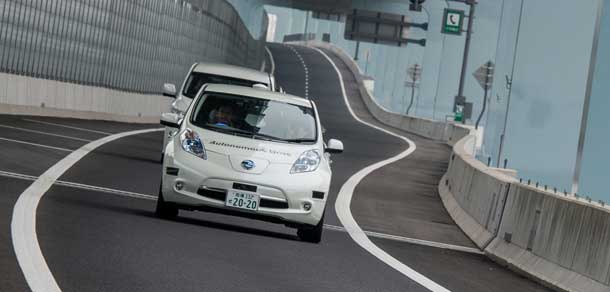There is something about Carl Kuhnke’s infectious charm that reminds one of Doc Brown from Back to the Future. They both have a bold vision for future technology which is at the same time exciting and a bit scary. And coincidentally, they both work with high-tech vehicles.
Kuhnke is the managing director at Saskatchewan Centre of Excellence for Transportation and Infrastructure and previously served as the executive director of the Intelligent Transportation Systems Association of Canada. In his talk, his first task was to dispel any lingering notions that autonomous cars are some sort of far-off, hypothetical technology that exists now only in prototype. As Kuhnke made clear, autonomous vehicle technology, in whole or in part, is already here, already part of our lives and will become a much bigger part of our lives much sooner than we think.
“For the 2018 model year in Canada, all cars from the 10 major manufacturers will be equipped with frontal crash braking radar and rear cameras as standard equipment. Already today you cannot hit someone from behind due to distraction. Neither can you veer out of your lane or claim your blind spot made you cut someone off.”
And the current implementations are not limited to these partial measures.
“Google, Tesla, Audi, Mercedes, Denso, Delphi and others have logged tens of millions of miles with the only known at-fault accidents caused by human error. Major resource firms around the world are already using autonomous vehicles on their private lands, saving hundreds of dollars an hour in human operator costs.”
Kuhnke recalled his own experience monitoring an autonomous semi-trailer going 180 km/hour down the Autobahn in Germany.
“It was a weird experience but not in the way you might expect. It was weird because it was boring. The whole ride felt so smooth and safe.”
If we accept that autonomous vehicles are not hypothetical but imminent, the implications for engineers and society at large are enormous. It falls into the category that Kuhnke calls disruptive technology – one that will change everything it touches.
To Kuhnke, the biggest and most important effect of these vehicles is the reduction in harm to people and property. Studies estimate that autonomous vehicles could reduce collisions by unimpaired drivers by as much as 80 per cent.
Autonomous vehicles would also require that transportation engineers radically rethink the way they design roads. These vehicles can travel faster and more efficiently on less road space and with much less traffic congestion.
“Right now, we design roads for human error but now we can abandon that thinking. We don’t have to build more and more lanes or make them wider and wider because the autonomous vehicles are operating with much smaller margins of error.”
The autonomous vehicle might also make public transportation obsolete as people instead opt for on-demand cars such as Uber’s experiment with autonomous cabs.
“This all makes autonomous vehicles very attractive to governments. They offer the prospect of reducing the costs of health care, public infrastructure and public transit dramatically.”
Kuhnke estimates that the technology could save up to 100,000 lives a year and lead to a $30 billion a year drop in health care costs. As well, through reduced traffic congestion, up to 300 million annual tonnes of greenhouse gases would no longer be emitted.
Kuhnke also sees revenue potential for governments such as more efficient toll road systems where drivers pay for the precise distance they travel rather than flat fees for using toll roads.
With the money saved and earned, Kuhnke envisions that governments could invest in other kinds of infrastructure, such as solar-powered roads that could be embedded with guidance sensors while also keeping roads ice-free.
The implications for engineers are countless. Road design and land use policies would have to be reconfigured. Traffic systems such as traffic lights would become effectively obsolete. Autonomous vehicles would make automatic adjustments for road construction which would allow work zone safety to be enhanced.
While the autonomous vehicles offer many potential benefits, they also have troubling aspects, many of which were raised in the question and answer session.
How would autonomous vehicles fare on Canada’s icy roads? Kuhnke maintains that ground-penetrating radar would allow the vehicles to adapt to any road conditions. They would even adapt for minor road repair annoyances such as poorly painted lane lines.
“The vehicles position themselves in relation to the road and other vehicles. You don’t even need painted lines as long as you’ve got the slope of the road right.”
Many have questioned how these vehicles would make ethical choices. In the classic dilemma, if no other options were available in an emergency situation, would an autonomous car plow into a crowd of people but save the driver or drive over a cliff, saving the group of people but killing the driver? Kuhnke acknowledged that these are issues that need to be worked out on a societal level and some of them may not be perfectly resolvable.
As Kuhnke himself pointed out, autonomous vehicles are part and parcel of the concept of the internet of things – devices that communicate, share data and interact with each other. With this in mind, what are the implications of cyber-security? Could a cyber-terrorist seize control of vehicles and transit systems and cause mayhem on the roadways? Kuhnke acknowledged that this problem was unsolved at present and would require serious attention.
Yet for all of these potential potholes, trends in the automotive industry make it clear that autonomous vehicles are coming down the road fast. As guardians of public safety, engineers will be challenged to either get on board or get run over.
